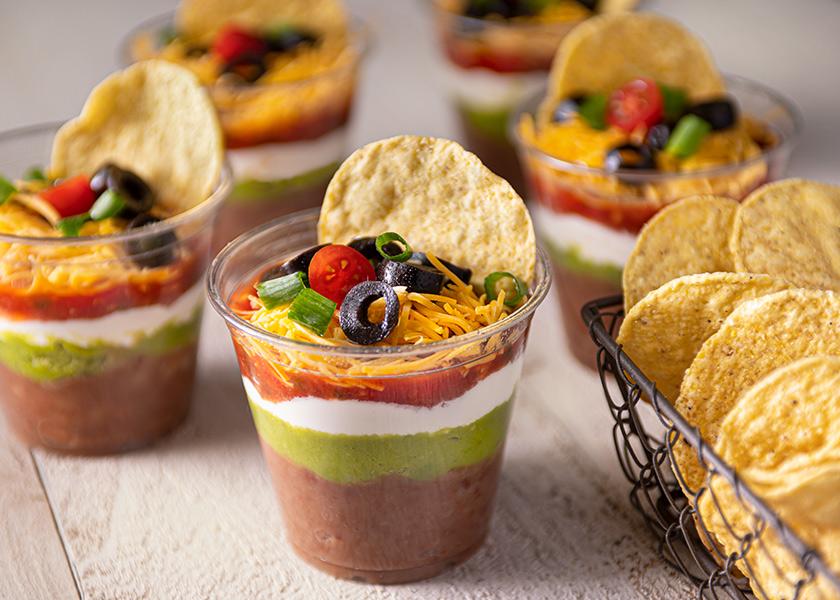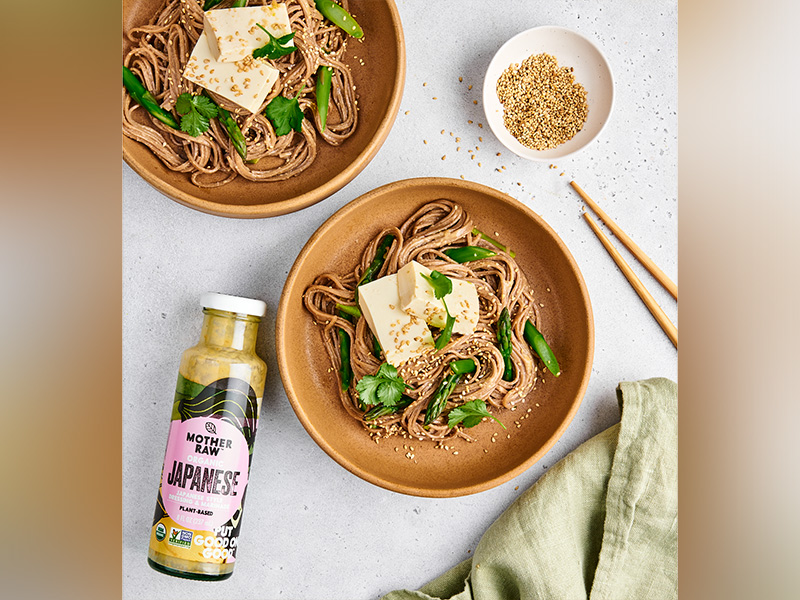Consumers dive into dips and dressings

As the vast majority of meals were consumed at home during the height of the COVID-19 pandemic, consumers learned how to enliven mealtime and snacks — with dips, dressings and marinades often playing an important role.
“As consumers continue to eat and snack at home, dips and spreads can be there to amplify snacks, meals and appetizers with flavor and texture,” Kelly Olson, food and drink analyst with Mintel, said in a recent report, “Trending Flavors and Ingredients in Dips and Sauces 2023.”
“Products that can prove their versatility at a variety of occasions will help earn their spot in both routine and special occasions,” Olson continued.
Over the past five years, the dips and spreads market has grown by 25% (10% when adjusted for inflation), Mintel said in the report, and it predicts that the market will reach $7.4 billion by 2027.
Dips, spreads, dressings and sauces can bring excitement to foods Americans are already eating. They also can boost snack experiences and lend indulgence to a variety of meals.
A recent keynote by Datassential showed that while consumers experiment with dips and sauces when dining out, when at home, comfort rules and they lean into familiar offerings like ranch, Italian and Caesar.
Data from NielsenIQ shows that in the produce department, for the year ending May 27, sales of bean dips (up 32%), onion dips (up 27%) and spinach dips (up 23%) grew the most in the 52 weeks ending May 27, 2023, but sales of caramel and chocolate dips also grew surprisingly strongly (by 12% and 8%, respectively). For the same period, sales were strong on dressings, especially Mediterranean (up 12%), Asian (up 9%) and coleslaw dressing (up 9%).
Mintel’s research shows salsa is the most popular dip; followed by cheese dips, like queso; creamy dips; hummus; and guacamole.
Bashas’ supermarkets have seen an overall 17% increase of salad dressing sales and within the category a 31% increase in premium salad dressing sales, said Dave Vehon, category buyer.
Consumers look for healthier options, he added, especially low sugar and sodium contents and alternative oils such as avocado or soy.
“Millennial and Gen Z consumers are more focused on reading labels and looking for healthier products,” Vehon said. “The increased popularity in social media influencers has also led to more health-conscious cooking and eating.”
Prime attributes
Consumers are looking for unprocessed and whole food ingredients first of all, said Kristi Knowles, CEO of Toronto-based Mother Raw, which offers more than 20 dressings, marinades, dips and quesos.
“We try to allocate as much space [on packaging] as possible to our ingredients because this what consumers really want to know,” Knowles said.
But also important are organic and non-GMO certifications, plant-based ingredients and dairy-free. These callouts are typically on the front of packages, but where relevant, Mother Raw also states that products are kosher certified on side and back panels.
Yo Quiero, whose product line includes quesos, guacamole, salsas and dips, also calls out its attributes on packaging.
“Our products have no preservatives or anything artificial,” said Tara Murray, vice president of marketing. “We put this on our packaging along with vegetarian, gluten-free, vegan where applicable, and keto-friendly.”
As people gather again, Hy-Vee Inc. supermarkets are seeing dips become more popular.
“Many customers have opted for appetizers and dips to share. And when it comes to dinner parties, people are leaning toward more substantial appetizers,” said John Griesenbrock, vice president, produce and floral.
But it’s not just for gathering — guacamole is a crowd-pleaser for many eating occasions, he points out.
“Our customers are getting more creative with how they enjoy their guacamole, using it as a topping on toast or even incorporating it as a meal supplement,” he said.

Calling out collaboration
Collaborations with other partners, including produce companies, is key to Mother Raw’s marketing strategy. Knowles has worked with lettuce growers on promotions such as giving away lettuce and dressings for a year; or buy a bag of lettuce, get a Mother Raw dressing free.
Yo Quiero runs programs with Dandy and its celery sticks because dips and celery work well together.
“We like to work with brands that share our philosophy of better-for-you items and especially those that encourage more produce consumption,” said Jay Alley, co-owner and vice president of sales for Fresh Innovations LLC, which owns the brand.
Mini options
Most recently, Knowles launched Mother Raw’s single-serve program.
“Many single-serve dressings are full of highly processed oils and ingredients that are difficult to pronounce, so Mother Raw is offering an organic, plant-based, allergen-friendly offering,” she said. “We just launched a program that allows shoppers to purchase a Mother Raw single-serve sachet with a store-made salad as an on-the-go option. It’s a great way to encourage trial.”
Through a new partnership, Mother Raw dressings will be featured in high-end lettuce kits. And through another, one retailer will merchandise Mother Raw single-serve dressings on racks that slide into the in-house salad section.
Yo Quiero minis are merchandised with the brand’s other items either in the produce or deli department. Sales jump during the summer months and for school “because they are super easy to toss into coolers and lunch boxes,” Alley said. And another plus: They can be frozen, meaning they can go straight from the freezer to the lunchbox.
Merchandising spots
Dips, dressings and sauces increasingly are made from fresh products without preservatives, so they are merchandised from refrigerators. And ideally, they’re in the produce department so consumers can make the easy connection of pairing them with vegetables.
Knowles prefers Mother Raw products to be merchandised together as a set.
“When Mother Raw dressings and dips are shelved together, creating a brand block, our velocities increase,” she said. If this placement isn’t feasible, she likes her dressings and marinades next to lettuces, and dips in the deli section.
Yo Quiero places refrigerated dips either in a retailer’s deli or produce section, but it depends on the store.
“We provide the retailer with two packaging options that allows them to put fresh-cut cups in the produce section and around Yo Quiero packaging in the deli,” Murray said.
More Hy-Vee customers are choosing healthier options.
“We place our pre-cut vegetables and fruits near dips in the produce section to provide a healthy alternative to chips and crackers,” Griesenbrock said.
Dressings in this department are refrigerated, he adds, and also when they are merchandised with charcuterie.
Hy-Vee also showcases dips alongside chips, crackers and pita chips.
“This helps make our customers’ shopping experience easier and more enjoyable, knowing they have a great snack to share with family and friends,” Griesenbrock said.
Boosting purchases
Dip sales peak around the winter holidays at Hy-Vee, “especially when customers spend more time with family and friends and attend holiday gatherings,” Griesenbrock said, as well as in the summer when they go with fresh fruits and veggies. But dressing sales typically peak at the start of every new year “as our customers focus on healthier eating,” he said.
At Bashas’, salad dressing sales increase during the summer months when consumers seek lighter meals. Dip consumption increase when gatherings occur such as the Fourth of July and the holidays.
Manufacturers use social media to boost purchases and gain awareness.
“Social media is where Mother Raw is able to deeply connect with our target consumers by sharing the content they tell us they want from us, including simple recipes, tips, educational information, user-generated content and some fun, cheeky Mother Raw attitude,” Knowles said.
Yo Quiero says social media is “a great way to reach consumers and have two-way conversations about our products, recipes, etc.,” Murray said. Yo Quiero also works with social media influencers “that match our brand position and voice,” she added, and they provide amazing content such as recipes “and help us grow Yo Quiero brand awareness.”







